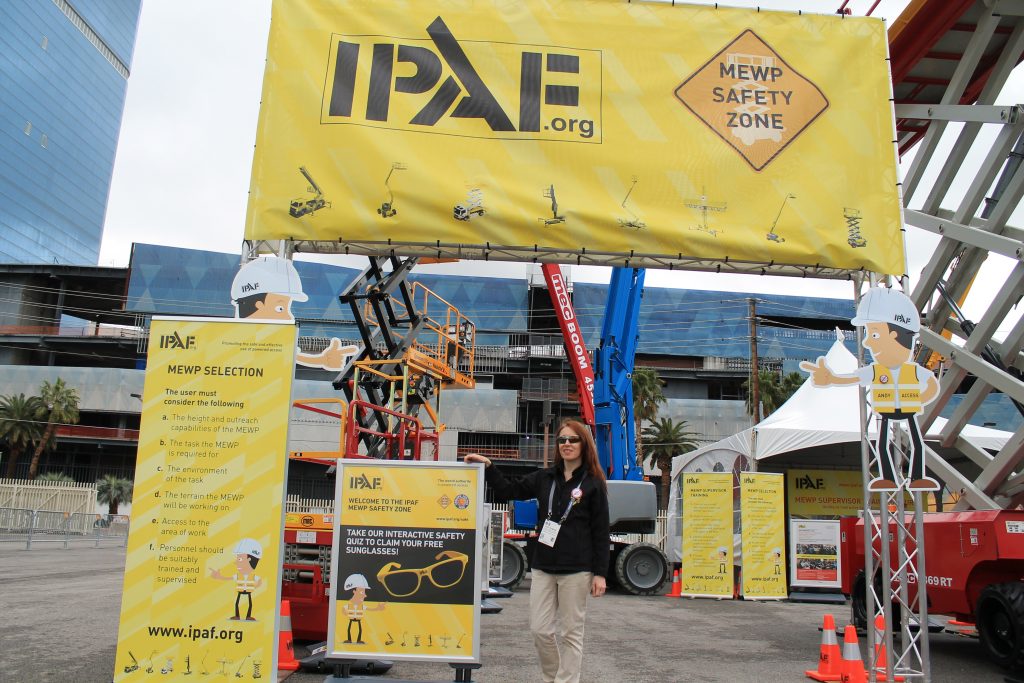
Features
IPAF at CONEXPO and releases report giving insight into MEWP accidents worldwide
March 19, 2020 By Crane & Hoist Canada
 Faith Cobaine, IPAF marketing and membership manager at the IPAF booth at CONEXPO/CON-AGG. Photo: Jay Koblun
Faith Cobaine, IPAF marketing and membership manager at the IPAF booth at CONEXPO/CON-AGG. Photo: Jay Koblun Accidents while using Mobile Elevating Work Platforms (MEWPs) are proportionally more likely when working in public areas or alongside roads than on controlled work sites such as construction sites, commercial or rental premises, according to the latest detailed safety analysis from the International Powered Access Federation (IPAF).
IPAF participated in CONEXPO/CON-AGG in Las Vegas, Nev., by setting up a MEWP Safety Zone on the fairgrounds. Faith Cobaine, IPAF marketing and membership manager, explained what IPAF does and directed individuals who want to know more to the IPAF website.
“IPAF promotes the safe use of powered access equipment worldwide by providing technical advice and information,” said Cobaine. “IPAF also influences and interprets legislation and standards through safety initiatives and training programmes.”
IPAF is a not-for-profit organization owned by its members, which include manufacturers, rental companies, distributors, contractors and users. IPAF members operate a majority of the MEWP rental fleet worldwide and manufacture about 85 per cent of platforms on the market.
The company’s goal at the construction show was to help visitors learn the answers to the following key questions:
- Why should I follow ANSI standards to keep my workers safe?
- What is a MEWP-specific safe-use plan – and why do you need one?
- Why must you train MEWP operators and those who supervise them?
- How can selecting the right MEWP save both time and lives?
- How can IPAF’s safety campaigns assist you in managing risk?
IPAF’s Global MEWP Safety Report 2016-2018 presents key findings from the federation’s analysis of accident statistics gathered through its worldwide accident reporting project, which has incident reporting from 25 countries around the globe. The report is now available to view or download on www.ipaf.org.
Accidents on construction sites account for the joint highest average number per year, but as MEWPs are used much more widely in construction than in other sectors and locations, they are in fact proportionally less likely to occur on a controlled work site than in a remote location or a public area, such as alongside a road, the report shows.
As well as the increased proportional risk of an accident occurring when working away from controlled job sites, the new report identifies recurring underlying causes of incidents involving MEWPs as falls from the platform, electrocutions, entrapments, MEWP tip-overs and MEWPs being struck by another vehicle. This is in line with previous years’ fatal accident analysis and demonstrates yet again that the industry should focus on ways to reduce underlying factors common to these types of incident.
“With this report there’s a new methodology to much of the analysis and the way the findings are presented, plus the report is interspersed with key recommendations to mitigate common risk factors,” says Richard Whiting, IPAF’s general market manager for UK and Ireland, who has been working to finalize the report and present the findings. “We’ve worked hard along with a dedicated group of IPAF members to analyze, interpret and present the data in a new way, to assist the wider industry to stay safe.”
“One key change is that, rather than comparing a full year’s accident data to previous years, the most recent three full years of available data have been combined to produce an aggregate and average number of incidents – combining data into a larger overall set allows trends over time to be more readily identified,” he says.
Other key indications
The industries in which deaths most frequently are forestry and construction, with maintenance and electrical service sectors third and fourth respectively. Both forestry and construction had an annual average of 19 reported fatalities, but the total number of days worked using MEWPs in construction worldwide is far higher than in forestry, so a fatal accident is proportionally more likely in the latter than on a construction site.
“Renewed focus must be brought to bear to warn managers and operators of the relatively higher proportional risks of a major or fatal accident when not working on a controlled, segregated work site. IPAF’s Street Smart safety campaign already seeks to do this; we must look at how best to evolve this campaign to help reduce electrocutions or other accidents in forestry, for instance,” says Whiting.
Peter Douglas, IPAF’s CEO & MD, a member of the UK Country Council was instrumental in initiating the ongoing worldwide incident reporting project in 2012.
“MEWPs are still among the safest ways to conduct work at height. When unplanned incidents do occur, it is vital we capture that data and analyze the resulting statistics to see what trends are occurring and to influence IPAF’s technical guidance, adapt our training programme and inform our safety campaigns.
“We must work with our members and all industry stakeholders to improve incident reporting. It’s vital that all incidents including minor mishaps and near misses are logged; this helps identify heightened risk and mitigate underlying factors to reduce the number of major accidents or fatalities that do occur using the knowledge gained,” said Douglas.
Print this page